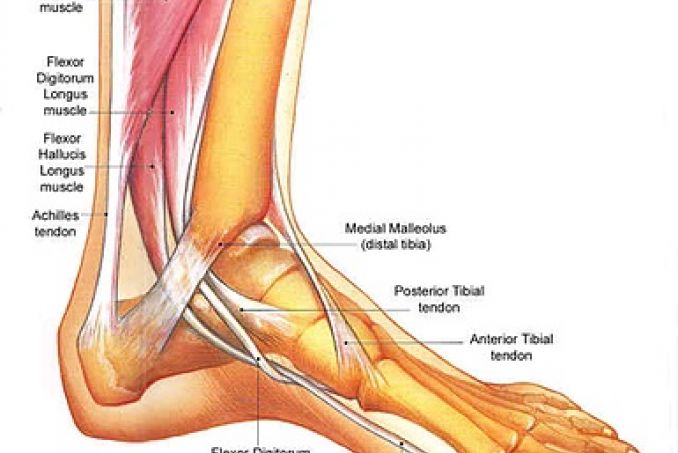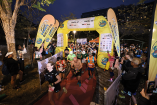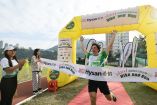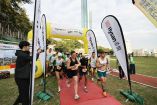Sprains, Strains and Ankle pains By Chris Watts
All runners want to be able to run fast. Light footed or fleet of foot as it used to be called.
The foot and ankle is the structural foundation stone for movement and locomotion. If there are weaknesses from old injuries or muscle deficiencies and imbalances then a chain reaction of twists and torque occurs right up through the kinetic or moving chain. It is only a question of time before the pain of sprains and strains start to occur.
Ankle sprains are the most common sports injury. Going over on your ankle usually implies that you had weak ankles in the first place. How many gyms and fitness centers are set up to train and stabilize your ankles? The body does not work piecemeal it is a mechanical chain of moving parts that work in synch with every system in order to propel you with efficiency and lightness. Weak ankles lead to weak knees and weak hips. All those 3 major joints work in harmony with each other and require stability from top down and bottom up.
I blame the footwear for most of the ankle, foot and toe problems that I see. Shoes are mostly made of non-organic matter and don’t breath and don’t resonate with the ground we tread on. If they don’t fit well and are generally too narrow we will loose our stable base. Toes start to cross over or hammer up, and our stride length shortens which slows us down diminishing performance and increasing the likelihood of attaining further injuries.
Do I dare broach the topic of the high heels? It is common knowledge that a 2-inch heel will throw our line of gravity and thus our pelvis forward by 18 to 20 degrees. That in itself will cause our ankles and feet to slip forward in the shoe where we start to grab with the toes that lead to hammer, mallet and claw toes. The feet are the most important balance and stability appendage in our body structure and they get little attention until something goes wrong.
Strains and Sprains around the ankle are cause and effect. One of my Swiss clients was regarded as the fastest downhill runner in Hong Kong was able to shimmy down a mountain like the proverbial mountain goat and could hit rocks and boulders of any size and at any angle and carry on regardless. He had the strongest ankles I had ever seen.
With tens of thousands of ankle injuries occurring daily, most of them through sporting activities, including jogging on uneven surfaces and playing squash at breakneck speeds or the full twisting forces from landing in basketball, we all need to spend a bit more time assessing, mobilizing and stabilizing those forgotten shock absorbers that are our feedback mechanism to the ground we tread upon.
Once injured, the reeducation and retraining should take place immediately. Even if post injury you can only achieve 1 degree of movement, it must work through the as actively and dynamically as is feasible.
Your nervous system can only change if you make it change. I would wisely warn against purposely putting your ankles at risk by wearing unsupportive shoes or getting back in the game before an injured ankle has healed properly.
Ankle injuries should never be taken lightly and are too often mistreated or not treated at all. Get the mobility back as quickly as you can and then start to gain the stability by performing manual resistance exercises on the foot evertors, invertors as well as the dorsi and plantar flexors. If you play sports on the ankle too early the result will be an ankle prone to prolonged discomfort, re-injury, chronic disability and early onset of inflammation or arthritis.
Over half of all athletic injuries are ankle strains and sprains. According to a report by the trainers’ association, the highest incidence of ankle injuries occurs in field hockey, followed by volleyball, squash, football, basketball, ice hockey, lacrosse, soccer, rugby, track and field, and gymnastics.
Other reasons for ankle injury among athletes include landing awkwardly from jumps, as in basketball where the landing forces can be 6 times your own body weight. Also we see injuries from athletes stepping on other player’s feet and toes. Running injuries occur on the heels when landing too hard on the heels from overlong stride lengths and or tight calves and soleus muscles.
What should be abandoned is the temptation to try to walk off the pain of a sprained ankle. In fact, in years past, that’s often what athletes were advised to do. But trying to walk on an injured ankle is precisely the wrong approach. Have the joint and tissues properly evaluated for heat, swelling, tenderness, discoloration and scarring. Moving the joint under the supervision of a professional sports therapist to improve the range of motion and icing it not longer than 10 minutes to reduce the pain. Apply cold for 10 minutes at a time, then remove it for 10 minutes and reapply. When using an ice pack or chemical cold pack, cover the skin first with a wet cloth to avoid tissue damage. Icing can also be used to reduce discomfort before doing exercises prescribed to strengthen an injured ankle.
You may also want to raise the foot to increase the drainage and flow of the lymphatic system that works as the bodies own sewage removal.
For people who are physically active and those who are sedentary, the only consistent risk factor for an ankle injury is having suffered a previous sprain. This fact alone underscores the importance of giving ankle injuries the total respect and treatment they deserve.
No longer are prolonged periods of rest recommended. The emphasis now is on active myofascial movement modalities— getting clients or patients moving as soon as possible (MICE) doing walking exercises and most important of all, and often the most neglected, is balance training, which starts with standing on one foot (the injured one) on a firm, even surface, then on a foam surface or Bosu ball, first with eyes open, then eyes closed.
The idea is to force the ankle to move under more unstable conditions, as you’d find on the pavement, lawn or the beach
Ankle problems are a common risk factor for falls among the elderly, and the stronger the muscles in the lower leg, the more support they provide for the ankles. Don’t forget to work the thighs, buttocks and hamstrings.
Plan to do your entire ankle retraining at least 3 times a day until you can walk and later jog without pain.
Ladies take note this writer strongly suggests the only place to wear high heels is in your bedroom!!
Chris Watts is the founder of Motion Dynamics.
For further information on mobility training please contact Chris at chris@chriswatts.biz
Or come and visit his team at:
Crossfit Asphodel
G/F Nam Hung Mansion, Shop 11, 22-23 Praya
Kennedy Town, Hong Kong
3568 7719
www.chriswatts.biz







/CBREMKC_9735_HK_Logo web banner-01.jpg)
/RoyalInt300100banner.jpg)
/HysanWebBannerDesign300.png)